Genre: Sports Developer: SIMS Co. Ltd. Publisher: Sega of America Players: 1-4 Released: 1994
Do you want to create and customize your own tennis player, and put him through the rigors of a life on tour? Are you and your friends looking for a quick four-player doubles game? Or have you ever wanted to watch Arthur Ashe take on Michael Chang? If so, then 1994 was a good year for you, since Sega’s newly released 16 MEG sports title, ATP Tour Championship Tennis, offered all these options and more.
Actually, ATP Tour Championship Tennis wasn’t quite as new as it might have seemed. Though it doesn’t advertise itself as a sequel to Wimbledon Championship Tennis, it’s clear that the underlying engine is the same, and anyone who’s played the earlier game will feel right at home here. The balls triking feels very similar, and some tactics that worked well in Wimbledon — like repeatedly catching your service toss to manipulate the CPU’s position and eventually get an easy ace — will work in ATP too.
That said, there have clearly been a few refinements to the controls that make ATP a friendlier experience. Wimbledon‘s “manual control” option was essentially unplayable, with timing so finicky that just making contact with the ball was an achievement. The manual (or “Normal”) mode in ATP Tour Championship Tennis, by contrast, is what Wimbledon‘s should have been: smooth, natural, and straightforward. However, it doesn’t make any use of the extra buttons on the six-button controller, which is disappointing for a 1994 release.
Replacing Wimbledon‘s generic cast of pre-fabricated characters is a full roster of what the box art describes as “32 of today’s top players”. These real-life pros range from household names like Ivan Lendl, John McEnroe, and Pete Sampras to obscure journeymen like Carlos Costa and Amos Mansdorf. However, some of the era’s best players are missing, most notably Andre Agassi, Boris Becker, and Jim Courier.
Also included are eight of the game’s historical greats, including multiple Grand Slam winners Ken “Muscles” Rosewall, Ilie “Nasty” Năstase, and the renowned “Rocket” Rod Laver. These legendary players are available in the ATP SENIOR Tour Event mode, and can also be used against players from any era in an exhibition match.
Speaking of Grand Slams, the makers of ATP Tour Championship Tennis apparently didn’t secure a license from those events, so there’s no Wimbledon or French Open to be found here. However, the game does feature a full calendar of 10 actual tour-level events, like Key Biscayne (then called the Lipton Championships) and the Italian Open. At the end of the season, the top 8 players qualify for the IBM/ATP Tour World Championship. All events consist of five rounds of three-set matches, except the final match of the World Championship, which runs five sets.
Once you’re done playing one-shot exhibitions, the meat of the game lies in its career mode, which begins at the start of the 1995 season. ATP Tour Championship Tennis has you design your own player from scratch, specifying his nationality, birth date, height, weight, hairstyle, skin and clothing color, and shot selection. At the start of his career, you assign a total of 10 points to seven different stats: serve power/control, forehand and backhand power/control, and footwork. Each of these can range from 0-10, and at the end of a tournament, you earn one ability point for each round you won, up to a maximum of five points for the tournament winner.
However, with the exception of footwork, the effect of these stats is subtle at best. Nor do any of the other player attributes, including height, seem to have much effect on play. My character of choice was a hulking 6’3″ Swedish teenager with a cannonball serve, but when I created a four-foot-tall, five-year-old, 80-pound Croatian rookie, his starting abilities — including a 130mph first serve — seemed much the same.
Furthermore, the game’s built-in players bear only a modest resemblance to their real-life counterparts. Sure, John McEnroe likes to rush the net, and Michael Stich probably has the game’s nastiest serve, but generally speaking the players are disappointingly interchangeable. Still, at least the designers made sure Laver was left-handed (unlike IMG International Tour Tennis, which took the most accomplished southpaw in tennis history and unforgivably made him a righty).
That said, as I noted above, the basic gameplay in ATP Tour Championship Tennis is solid and works well. There are far too many tennis games out there in which the computer never makes errors, or can never be aced — but refreshingly, this isn’t one of them. With the exception of its brutally accurate defensive lobs (which always seem to land with pinpoint precision on the baseline), the computer makes mistakes that seem to flow naturally from the circumstances of play. If it has to dive for the ball, the ensuing shot is likely to sail out; if it tries to hit a winner off a low-bouncing slice while close to the net, there’s a good chance it’ll dump the ball into the net. It’s occasionally vulnerable to aces and will even double-fault on occasion. Right through to the end, all of the players remain human and fallible, and I certainly never encountered anything like the over-juiced opponents in Wimbledon (some of whom, in the last part of the game, became invincible net-rushers who could unfailingly return an overhead smash with a perfectly placed winner of their own).
ATP Tour Championship Tennis includes a battery-backed save game function, which is a welcome upgrade from Wimbledon‘s password system, and offers four slots. Humanely, it allows you to save your game after every match, not just after a full tournament. It also supports up to four simultaneous players using the Sega Team Player multi-tap.
So what’s wrong with ATP Tour Championship Tennis? Well, for one, the presentation isn’t always as good as it should be. The player graphics and animation are competent, but the sprites don’t reflect the character’s height or weight (and why include the option if it’s meaningless?). The court has an unappealing, dithered look that’s usually associated with SNES “downports”, not a first-party title. The various tournaments are little more than palette swaps with a couple of billboards added, so a hard-court event in California otherwise looks – and plays – the same as a clay-court tournament in Italy. Even a splash screen with a single digitized graphic from each host city would’ve added some sense of place.
The umpire uses an extensive library of vocal samples, including the surname of every real-life player, and speaks with a genteel British accent. His voice is clear, though the audio encoding that was used left residual artifacts that make it sound as if he’s being transmitted through a shortwave radio or ring modulator. The music is average, and the gameplay noises merely functional, but the designers did include a clever Easter egg: during the brief pause at the end of each game, you can trigger one of ten different samples of trash-talk by inputting a three-button code. (AAA is “Yeah!,” BAB is “Are you blind?!,” CBC is “Awww, that’s a terrible call!,” and so on.) If you’re quick, you can trigger up to three in a row, but unfortunately the samples are the same for every player – no Croatian accents here.
A deeper problem is that the AI has one or two holes that are far too easy to exploit. In particular, the computer often fails to return to center after it’s been pulled out wide by a kick serve or a cross-court slice, even if it has plenty of time to get back. This leaves the court wide open for an easy winner.
ATP Tour Championship Tennis is also one of several titles on the Genesis that allow the player to take a super-aggressive stance in the return game, standing practically on the service line to receive serve. You have to respond almost instantly but, with quick reflexes, you can reliably blast even the fastest serves up the line and into the corner for a winner. (Paradoxically, this means the biggest servers are often the easiest to break — they’ve hardly finished serving when the return goes whizzing by them — and the most dangerous serve is a medium-speed ball that comes too quickly to take a second swing if you hit the button early.) Though it’s a fun loophole to exploit, it’s one that the designers should have anticipated, and it risks breaking the gameplay dynamics.
Readers who are clever at math will have noted earlier that you start out with 10 ability points, and can earn 55 more by winning all 11 events in a year, but you’d need a total of 70 points to max out your abilities. Is this the game’s elegant way of showing that you can’t have it all, and have to favor some strengths above others? Alas, no: you’ll max out your stats soon enough, because ATP Tour Championship Tennis expects you to play three consecutive seasons, from 1995 to 1997. Only then does it give you an ending, be it good (“You are a true legend!”) or bad (“Keep practicing”), which seems to reflect your performance in the year-end championships and little else.
All this underlines the game’s core problem: it’s too easy, too long, and too repetitive. Beating ATP Tour Championship Tennis, and getting the “good” ending, will require putting hours and hours into matches that, for all intents and purposes, are indistinguishable from one another. It’s true that you don’t have to play every tournament since, with the exception of the World Championship (which is mandatory for all qualifying players), the player can decline his invitation to any event and sit it out, though his competitors will benefit in his absence. But even with perfect play you’ll need to win at least three tournaments each year to qualify for the year-end championships, so beating the game means playing, at a minimum, over 120 sets of tennis!
That’s just too much, and ultimately turns ATP Tour Championship Tennis into a tiresome slog, especially in light of the game’s lackluster challenge. I went completely undefeated in my playthrough, and the only set I dropped in almost 200 matches was in the very first match I played, when I was still figuring out the controls. At one point in the third season, I won eighteen consecutive 6-0 sets, spanning an entire tournament and more. It got to the point that my only real source of amusement was finding new and incongruous ways of combining the trash talk samples (“That was out! That was in!”). It’s senseless to force a player to endure that kind of empty repetition just to complete the game.
The Genesis’s roster of tennis games is littered with cynical cash-ins (hello there, Andre Agassi Tennis) and horribly shoddy programming (here’s looking at you, IMG International Tour Tennis). ATP Tour Championship Tennis isn’t one of these, and I see it as a sincere attempt to improve upon its predecessor. But while it raises the bar in some ways, it just doesn’t offer enough content to justify its own ambitions.
Ultimately, there are two kinds of people who are likely to play ATP Tour Championship Tennis: casual gamers seeking a quick game of singles or doubles with friends, and hardcore types like myself who will doggedly stick with a game to the bitter end. Otherwise, the game’s above-average court feel and ball dynamics, and its roster of real-life players and past legends, don’t quite compensate for its lack of depth, weak challenge, and excessive length.
SCORE: 5 out of 10

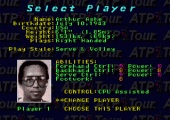
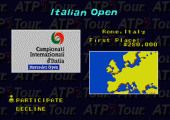
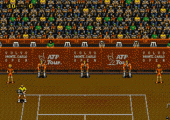
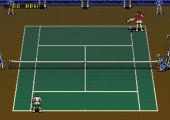
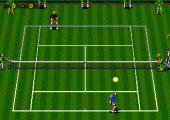
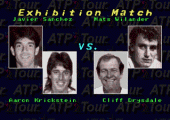
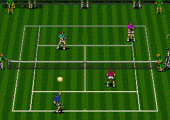
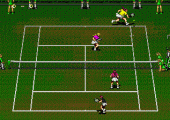
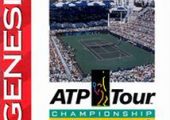
Recent Comments